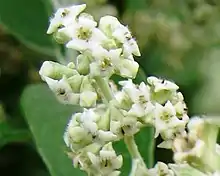Buddleja cordata
Buddleja cordata is endemic to Mexico, growing along forest edges and water courses at elevations of 1500–3000 m; it has also naturalized in parts of Ethiopia.[1][2] The species was first described and named by Kunth in 1818.[3]
| Buddleja cordata | |
|---|---|
 | |
| Buddleja cordata flowers | |
| Scientific classification | |
| Kingdom: | Plantae |
| Clade: | Tracheophytes |
| Clade: | Angiosperms |
| Clade: | Eudicots |
| Clade: | Asterids |
| Order: | Lamiales |
| Family: | Scrophulariaceae |
| Genus: | Buddleja |
| Species: | B. cordata |
| Binomial name | |
| Buddleja cordata | |
| Synonyms | |
| |
Description
Buddleja cordata is a large deciduous dioecious shrub or tree < 20 m tall in the wild. The trunk, which can reach 45 cm in diameter, has a furrowed bark, brownish or blackish in colour. The ovate to narrowly elliptical leaves are opposite and paired, 4–23 cm long by 3–14 cm wide, on petioles 1–4 cm long. The terminal inflorescences are paniculate, 6–30 cm long with at least two orders of branches, the lowermost subtended by leaves, the uppermost by small bracts. The small fragrant flowers are grouped into shortly pedunculate cymules, the corollas white, cream, or yellow, with a flush of orange at the throat, 1.5–2.5 long. Ploidy: 2n = 76 (tetraploid).[1]
 10-year-old B. Cordata
10-year-old B. Cordata.jpg.webp) B. cordata leaves
B. cordata leaves B. cordata panicle
B. cordata panicle
Cultivation
The species is cold hardy in the UK. A large specimen grows in the Centenary Border of the Sir Harold Hillier Gardens in Hampshire, another as part of the NCCPG national collection at Longstock Park Nursery, also in Hampshire.[4] Hardiness: USDA zone 8. [5]
Uses
The species (and the genus as a whole) contain secondary metabolites such as flavonoids and iridoid glycosides which have shown much promise in the treatment of cancers and a wide range of other disorders.[1]
References
- Norman, E. M. (2000). Buddlejaceae. Flora Neotropica 81, New York Botanical Garden, USA
- Leeuwenberg, A. J. M. (1979) The Loganiaceae of Africa XVIII Buddleja L. II, Revision of the African & Asiatic species. H. Veenman & Zonen, Wageningen, Nederland.
- Nova Genera et Species Plantarum, 2: 348–349, t.185. 1818.
- Moore, P. (2012). Buddleja List 2011-2012 Longstock Park Nursery. Longstock Park, UK.
- Stuart, D. (2006). Buddlejas. Plant Collector Guide. Timber Press, Oregon, USA. ISBN 978-0-88192-688-0